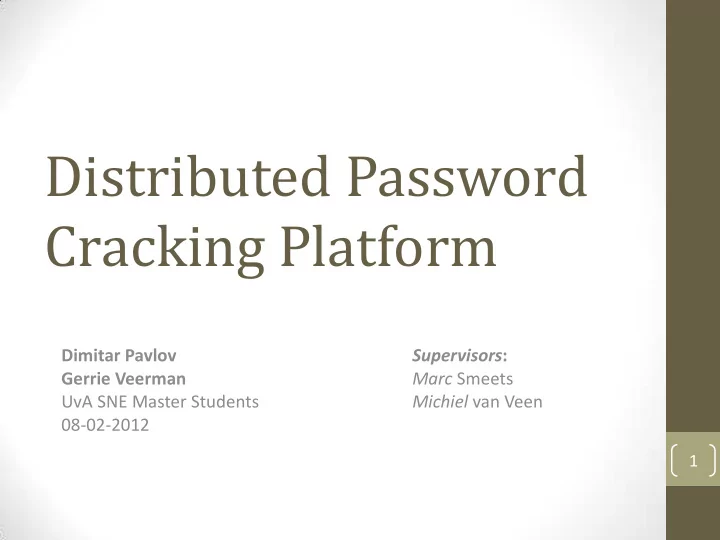

Distributed Password Cracking Platform Dimitar Pavlov Supervisors : Gerrie Veerman Marc Smeets UvA SNE Master Students Michiel van Veen 08-02-2012 1
The project • Research Question : How can a scalable , modular and extensible middleware solution be designed for the purposes of password cracking , so that it is based on existing cracking tools and allows for the use of a dynamic and adjustable cracking strategy ? • Why: The need for a distributed password cracking system, which can work with both CPU and GPU capabilities • Approach : -Formulate system requirements -Research and creation of system designs -Proof of Concept • Related Work : • KPMG's previous research projects 2 • Other work
Making the scope clear • What we did: • Use existing cracking tools • Set requirements and make a distributed system design which is scalable, modular and extensible • Develop the basis for such a design • What we didn’t do: • Create our own cracking tool • Design of cracking strategy 3
Research & Creation • Distributed Systems • System Design • Architectures • Technical • Communication • Functional • Cracking Tools • Proof of concept • CPU • GPU • Both 4
System Overview 5
User Requirements 6
System Requirements • Front-end Functionality • Controller Functionality • User Job Input • User input and request handling • Current Job Status • Worker nodes control • Job History • Dynamic cracking strategy • Stop Job • User notifications • Delete Job • Worker Functionality • Register a controller • Status request handling • Job processing 7 • Cracking tool support
System Design • System Architecture • Communication • Existing Cracking tools 8
System Architecture Design 9
Communicator Workflow 10
Dispatcher Workflow 11
Worker Node Workflow 12
Submitjob Example User 1: New job Request 15: Send Result or Status Request To User 6: Any Node Available? 5: Any Job Available? Check node 2 7: Determine Strategy Check node 1 2: Listener Accepts Job 8: Create subjobs 4: Put Job in DB 3: Check Credentials 16: Stop Other Workers 17: Cancel Job 10: Subjob 9: Dispatch Subjobs 10: Subjob 11: Start Cracking (GPU) 11: Start Cracking (CPU) 12: Intermediate Updates 13: Send Result back 12: Intermediate Updates 13: Job Finished 13 18: Stop Worker and Clean Up 14: Worker Clean Up Done
Communication • Paradigms • Remote Procedure Calls (RPC) • Message-oriented communication • Protocol • Data Structures 14
Communication Messages & Data • Protocol • Controller Messages – requestStatus, deleteJob, etc. • Worker Messages – requestStatus, stopJob • Asynchronous RPC – submitJob, sendResults • Data Structures Example: Subjob data structure • Reply • Hash • Job 15 • Subjob
Cracking Tools • Existing cracking tools • John the ripper (CPU) • oclHashcat-plus (GPU) 16
Proof of Concept - Overview Component: Progress: Used: • Website • Frond-end: Very simple <HTML> • Controller • Communicator: Finished <PHP> • Dispatcher: Very simple strategy <PHP> • Worker • Common code: Finished <PHP> • Tool specific: Basic John the Ripper <PHP> • Database • Controller: Finished <MySQL> • Worker: 17 Finished <SQLite>
Proof of Concept • Demonstration 1. Adding new node 2. Show database with jobs 3. Starting dispatcher 4. Intermediate hashes cracked 5. Job ready (result?) 18 6. Worker Clean up / Ready again
Conclusion • What was the research question again? • How can a scalable , modular and extensible middleware solution be designed for the purposes of password cracking , so that it is based on existing cracking tools and allows for the use of a dynamic and adjustable cracking strategy ? • Research • Distributed Architecture : Centralized • Transparency • Modularity • Concurrency • Simplicity • Communication : Message-Oriented / RPC 19 • Existing Tools : John the Ripper (CPU) / oclHashcat (GPU)
Project Achievements • Functional Specification : • System overview • Use-cases • System requirements • Technical Specification : • User interface • Controller • Worker • Database • Communication • Proof of Concept : • Website : very simple • Controller : working with simple strategy 20 • Worker : working with John the Ripper
Future work • Further development / fine tuning of the system modules • Extending to support other architectures (Cloud, Cell, etc.) • Implementing the following for the system: • Adding more tools and hashtypes • Tweaking for multiple OS’s (small changes needed) • Proper cracking strategy • Security for controller/node communication • Development of a proper front-end 21 • Testing / Benchmarking with many workers
Any Questions? 22
Recommend
More recommend